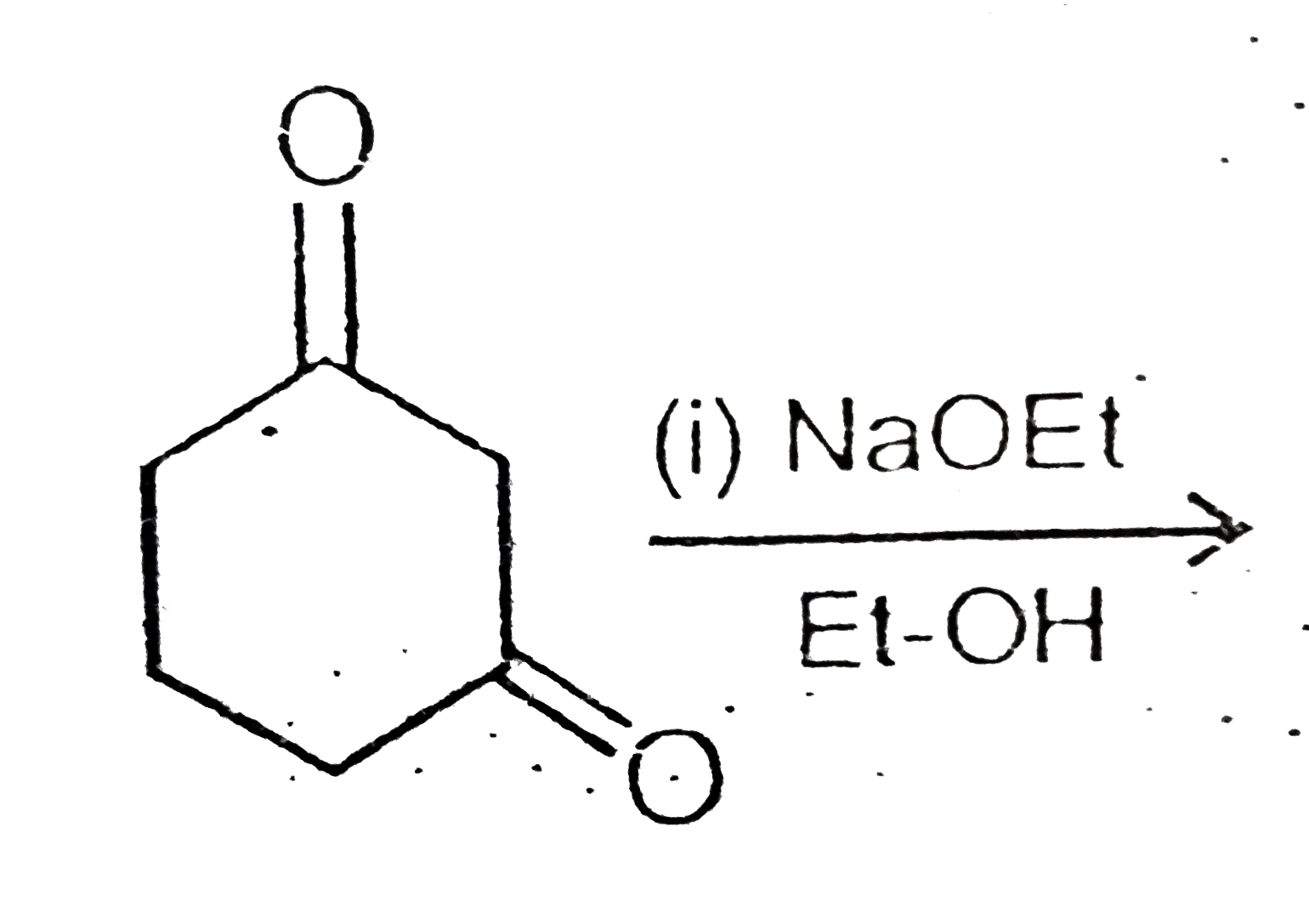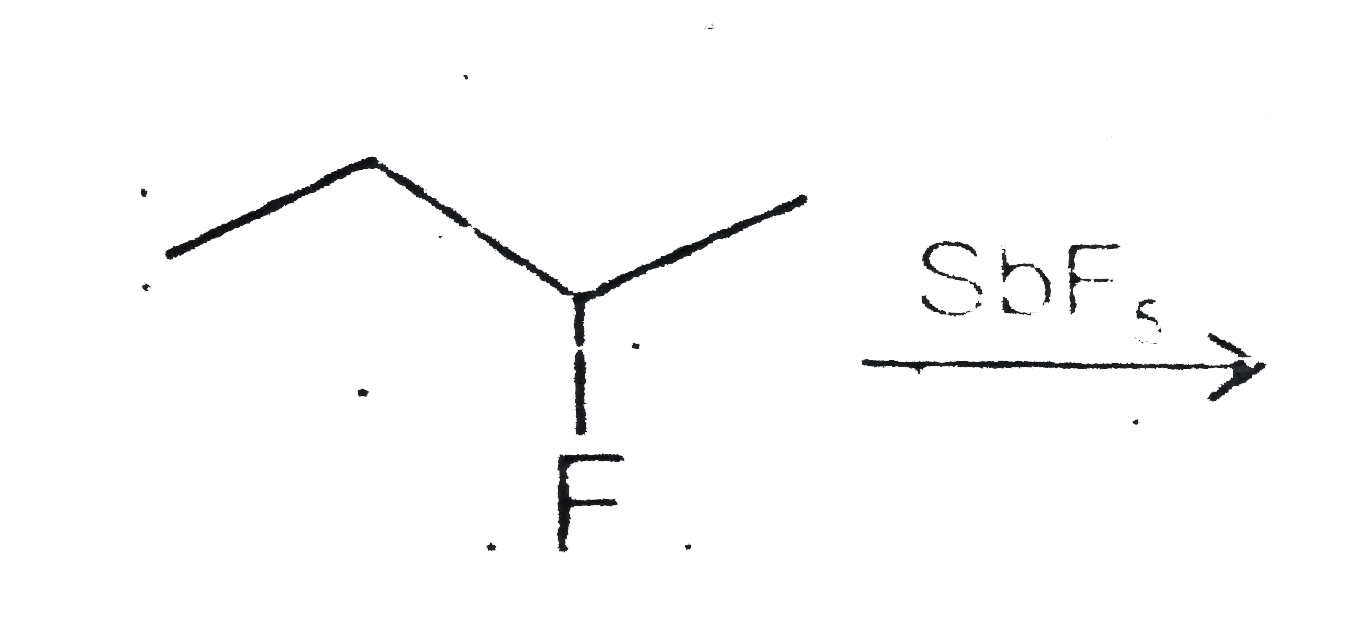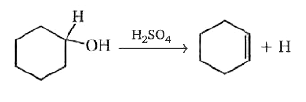Which of the following reactions will not generate a carbonion?



CH3−C≡C−HNaNH2/NH3−−−−−−−−→
The correct Answer is:C
To determine which of the given reactions will not generate a carbonion, we need to analyze each reaction step by step. A carbonion is a species where a carbon atom carries a negative charge, typically formed when a carbon atom gains an electron.
1. Identify the Compounds and Reactions:
- We have four different reactions to analyze:
1. Cyclohexane-1,3-dione with sodium ethoxide.
2. A compound with a nitro group (NO2) reacting with an amide (NH2).
3. A compound reacting with antimony pentafluoride (SbF5).
4. An alkyne (CH3C≡CH) reacting with sodium amide (NaNH2).
2. Analyze the First Reaction:
- Cyclohexane-1,3-dione + NaOEt:
- The sodium ethoxide acts as a base and can deprotonate a hydrogen atom from the carbon adjacent to the carbonyl group, leading to the formation of a carbonion.
- Conclusion: This reaction generates a carbonion.
3. Analyze the Second Reaction:
- NO2 compound + NH2:
- The amide (NH2) acts as a base and can deprotonate a hydrogen atom from the carbon adjacent to the nitro group, leading to the formation of a carbonion.
- Conclusion: This reaction also generates a carbonion.
4. Analyze the Third Reaction:
- Compound + SbF5:
- The reaction with antimony pentafluoride leads to the formation of a complex. Here, the carbon does not gain a negative charge; instead, it forms a positively charged complex.
- Conclusion: This reaction does not generate a carbonion.
5. Analyze the Fourth Reaction:
- Alkyne (CH3C≡CH) + NaNH2:
- Sodium amide acts as a strong base and can deprotonate the terminal hydrogen of the alkyne, leading to the formation of a carbonion.
- Conclusion: This reaction generates a carbonion.
6. Final Conclusion:
- The only reaction that does not generate a carbonion is the one involving antimony pentafluoride (SbF5).
Answer:
The reaction that will not generate a carbonion is the one involving antimony pentafluoride (SbF5).
---
- We have four different reactions to analyze:
1. Cyclohexane-1,3-dione with sodium ethoxide.
2. A compound with a nitro group (NO2) reacting with an amide (NH2).
3. A compound reacting with antimony pentafluoride (SbF5).
4. An alkyne (CH3C≡CH) reacting with sodium amide (NaNH2).
- Cyclohexane-1,3-dione + NaOEt:
- The sodium ethoxide acts as a base and can deprotonate a hydrogen atom from the carbon adjacent to the carbonyl group, leading to the formation of a carbonion.
- Conclusion: This reaction generates a carbonion.
- NO2 compound + NH2:
- The amide (NH2) acts as a base and can deprotonate a hydrogen atom from the carbon adjacent to the nitro group, leading to the formation of a carbonion.
- Conclusion: This reaction also generates a carbonion.
- Compound + SbF5:
- The reaction with antimony pentafluoride leads to the formation of a complex. Here, the carbon does not gain a negative charge; instead, it forms a positively charged complex.
- Conclusion: This reaction does not generate a carbonion.
- Alkyne (CH3C≡CH) + NaNH2:
- Sodium amide acts as a strong base and can deprotonate the terminal hydrogen of the alkyne, leading to the formation of a carbonion.
- Conclusion: This reaction generates a carbonion.
- The only reaction that does not generate a carbonion is the one involving antimony pentafluoride (SbF5).
The reaction that will not generate a carbonion is the one involving antimony pentafluoride (SbF5).
Topper's Solved these Questions
- ORGANIC CHEMISTRY: SOME BASIC PRINCIPLE AND TECHNIQUESBook:AAKASH INSTITUTE ENGLISHChapter:ORGANIC CHEMISTRY: SOME BASIC PRINCIPLE AND TECHNIQUESExercise:SECTION-C OBJECTIVE TYPE QUESTION (MORE THAN ONE OPTIONS ARE CORRECT)
Explore 18 Videos
- ORGANIC CHEMISTRY: SOME BASIC PRINCIPLE AND TECHNIQUESBook:AAKASH INSTITUTE ENGLISHChapter:ORGANIC CHEMISTRY: SOME BASIC PRINCIPLE AND TECHNIQUESExercise:SECTION-D LINKED COMPREHENSION TYPE QUESTIONS
Explore 7 Videos
- ORGANIC CHEMISTRY: SOME BASIC PRINCIPLE AND TECHNIQUESBook:AAKASH INSTITUTE ENGLISHChapter:ORGANIC CHEMISTRY: SOME BASIC PRINCIPLE AND TECHNIQUESExercise:ASSIGNMENT SECTION-A COMPETITION LEVEL QUESTIONS
Explore 50 Videos
- ORGANIC CHEMISTRY : SOME BASIC PRINCIPLES AND TECHNIQUES Book:AAKASH INSTITUTE ENGLISHChapter:ORGANIC CHEMISTRY : SOME BASIC PRINCIPLES AND TECHNIQUES Exercise:Assignment(Section-D)(Assertion - Reason Type Questions)
Explore 15 Videos
- POLYMERSBook:AAKASH INSTITUTE ENGLISHChapter:POLYMERSExercise:ASSIGNMENT (SECTION-D)
Explore 13 Videos
Similar Questions
Knowledge Check
Which one of the following reactions is not a redox reaction ?
AH++OH−→H2OBZn+2HCl→ZnCl2+H2C12H2+12Cl2→HClDZn+12O2→ZnOWhich of the following reaction is an elimination reaction ?
A B
B C
C Dboth (a) and (b)
Dboth (a) and (b)
Which of the following reactions is not a disproportination reaction ?
View SolutionWhich of the following reactions is/are not intermolecular redox reaction?
View SolutionWhich of the following reactions is a decomposition reaction ?
View SolutionWhich of the following reactions is an example of nucleophilic substitution reaction?
View SolutionWhich of the following reactions is an example of nucleophilic substitution reaction?
View SolutionWhich of the following reaction is an example of elimination reaction :
View Solution
